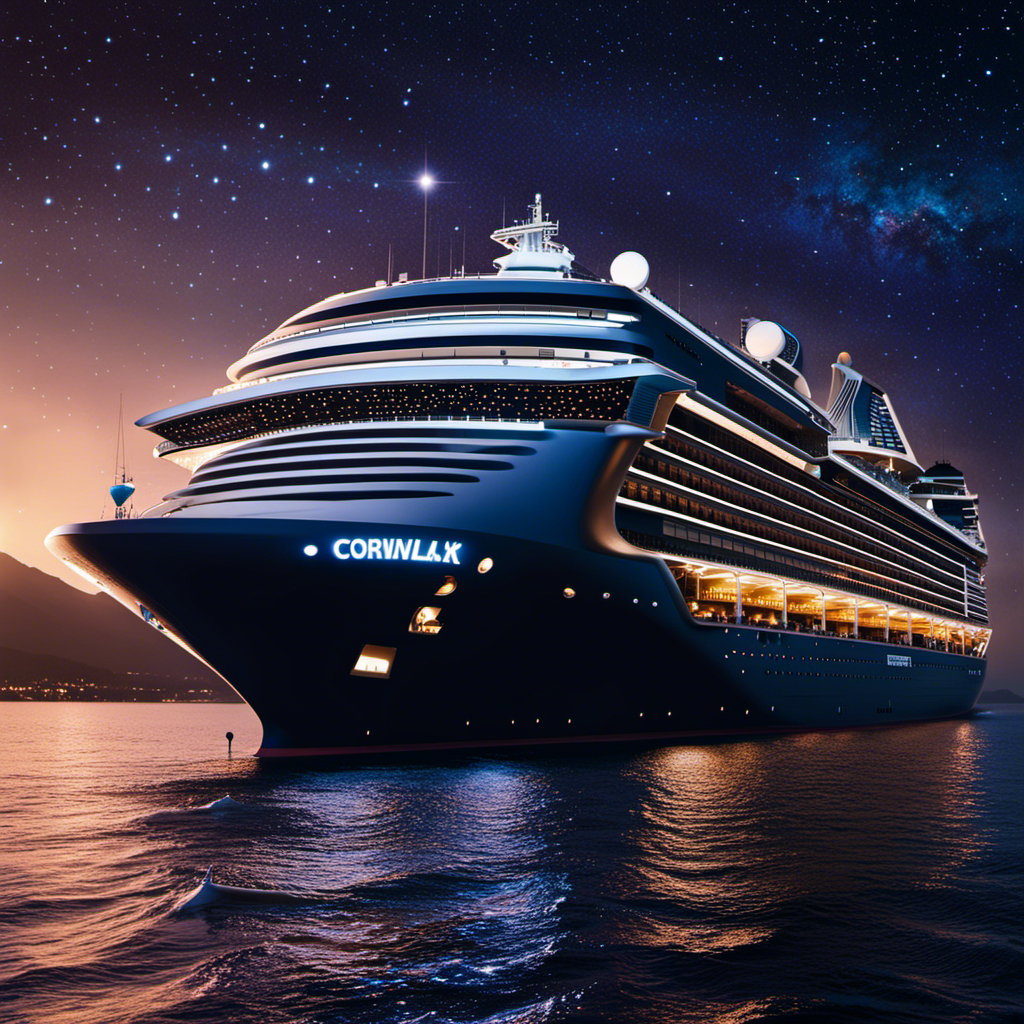As a frequent cruiser, I’ve always wondered about the common presence of norovirus on these luxurious ships. This worry is not mine alone, leading to a more detailed investigation into this highly contagious virus.
In this article, we will explore the factors that contribute to norovirus outbreaks on cruise ships, such as high population density and shared facilities. We’ll also discuss the challenges in controlling its spread and the efforts made by public health officials.
So, let’s dive in and uncover the reasons behind the common occurrence of norovirus on cruise ships.
Key Takeaways
- Norovirus spreads easily on cruise ships due to the fecal-oral route and contaminated food and water.
- Factors contributing to norovirus outbreaks on cruise ships include lack of effective quarantine protocols, inconsistent implementation of transmission prevention strategies, high population density, close quarters, and limited sanitation opportunities.
- Challenges in controlling norovirus spread on cruise ships include inadequate hygiene practices, high passenger turnover, shared dining facilities, and the constant influx and departure of passengers.
- Environmental conditions, such as the survival of norovirus on surfaces and in water, as well as its transmission through respiratory droplets, contribute to the risk of norovirus outbreaks on cruise ships.
The Nature of Norovirus
Norovirus is a highly contagious virus that causes stomach and intestinal inflammation. It is important to understand the factors affecting its transmission and the prevention strategies to combat its spread.
Norovirus is primarily transmitted through the fecal-oral route, meaning it can spread when infected individuals do not practice proper hand hygiene after using the bathroom. Additionally, contaminated food and water can serve as vehicles for transmission.
Prevention strategies include frequent handwashing with soap and water, especially before eating or preparing food, and after using the bathroom. Thoroughly cooking food and avoiding cross-contamination between raw and cooked foods is also crucial. Proper sanitation of surfaces and disinfection of contaminated areas are essential in preventing norovirus outbreaks.
Understanding these factors and implementing effective prevention strategies is key in reducing the spread of norovirus.
Now, let’s explore the factors contributing to norovirus outbreaks.
Factors Contributing to Norovirus Outbreaks
To avoid norovirus outbreaks, it’s important to frequently wash your hands and practice good hygiene while on board. However, there are other factors that contribute to the prevalence of norovirus on cruise ships.
One such factor is the lack of effective quarantine protocols. When a passenger or crew member is infected with norovirus, it is crucial to isolate them and prevent further transmission. Unfortunately, some cruise ships do not have proper quarantine measures in place, allowing the virus to spread rapidly among the passengers and staff.
Additionally, transmission prevention strategies, such as thorough cleaning and disinfection of common areas, are not always implemented consistently. This further facilitates the spread of norovirus.
With these factors in mind, it is evident that the high population density on cruise ships plays a significant role in the frequent outbreaks of norovirus.
High Population Density on Cruise Ships
Close quarters on cruise ships facilitate the transmission of norovirus. This is due to the proximity of individuals and the ease with which the virus can spread through respiratory droplets and contaminated surfaces.
With thousands of passengers and crew members in close proximity, it becomes difficult to contain the virus and prevent its spread.
Additionally, limited sanitation opportunities increase the risk of norovirus outbreaks on cruise ships. This is because proper hand hygiene and disinfection practices may not be consistently followed. As a result, the virus can persist and infect more individuals.
Close Quarters Facilitate Transmission
Due to the tight living spaces on cruise ships, it’s easier for norovirus to spread among passengers and crew members. The close quarters provide an ideal environment for the virus to thrive and transmit from person to person. Here are some reasons why the close quarters facilitate transmission:
-
Limited personal space: Passengers and crew members often share small cabins, making it difficult to maintain proper hygiene and avoid close contact with infected individuals.
-
Shared facilities: Common areas such as dining halls, entertainment venues, and recreational facilities increase the likelihood of virus transmission through contaminated surfaces and close proximity.
The transmission of norovirus on cruise ships has a significant impact on public health. Outbreaks can affect a large number of individuals within a short period, leading to severe illness and potential complications. Additionally, the confined nature of the ship can hinder effective transmission prevention measures, further exacerbating the spread.
As we explore the next section, it becomes evident that the limited sanitation opportunities on cruise ships increase the risk of norovirus outbreaks.
Limited Sanitation Opportunities Increase Risk
Make sure you take advantage of every available opportunity to sanitize your hands and surfaces, as the limited sanitation options on board put you at a higher risk for infection. On cruise ships, the ability to maintain proper hygiene is often compromised due to a variety of factors. For instance, the table below illustrates the limited sanitation opportunities on board and the potential risks associated with them:
| Limited Sanitation Opportunities | Increased Risk |
|---|---|
| Insufficient handwashing stations | Inadequate hand hygiene |
| Crowded common areas | Higher chance of person-to-person transmission |
| Shared bathroom facilities | Contamination of surfaces |
These factors create an environment where norovirus can easily spread. Insufficient handwashing stations make it challenging for passengers and crew members to thoroughly clean their hands, increasing the risk of transmitting the virus. Crowded common areas provide ample opportunities for person-to-person transmission through close contact. Additionally, shared bathroom facilities can become contaminated with norovirus, leading to the spread of the virus through contact with contaminated surfaces.
As we delve into the next section discussing shared facilities and contaminated surfaces, it becomes evident that these conditions further contribute to the prevalence of norovirus on cruise ships.
Shared Facilities and Contaminated Surfaces
To prevent the spread of norovirus on cruise ships, you should regularly clean and disinfect shared facilities and surfaces. Contaminated water sources and transmission through air particles are two key factors contributing to the prevalence of norovirus on cruise ships.
Norovirus can be present in water sources, such as swimming pools or hot tubs, if they are not properly treated or maintained. Additionally, the virus can be transmitted through tiny particles in the air when an infected person vomits or has diarrhea. These particles can settle on surfaces and contaminate them, leading to further spread of the virus.
Therefore, it is crucial to regularly clean and disinfect common areas, such as dining areas, restrooms, and handrails, to prevent norovirus from spreading. However, despite these preventive measures, challenges in controlling norovirus spread still persist.
Challenges in Controlling Norovirus Spread
Inadequate hygiene practices, high passenger turnover, and shared dining facilities are three key factors that contribute to the challenges in controlling the spread of norovirus on cruise ships.
Firstly, many passengers may not adhere to proper hand hygiene, which can facilitate the transmission of the virus.
Secondly, the constant influx and departure of passengers on cruise ships create a dynamic environment where the virus can easily be introduced and spread.
Lastly, shared dining facilities, where large numbers of people gather to eat, can serve as hotspots for norovirus transmission, especially if proper cleaning and disinfection protocols are not followed.
Understanding and addressing these factors is crucial in implementing effective measures to prevent and control norovirus outbreaks on cruise ships.
Inadequate Hygiene Practices
One reason norovirus is common on cruise ships is because passengers and crew members often don’t practice proper hygiene. Inadequate cleaning and lack of awareness contribute to the spread of this highly contagious virus. Here are three key factors that contribute to the inadequate hygiene practices on board:
-
Insufficient cleaning protocols: Cruise ships have a high passenger turnover, making it challenging to maintain cleanliness. Inadequate cleaning of surfaces and shared spaces can allow the virus to thrive and spread easily.
-
Lack of hand hygiene: Many passengers and crew members fail to follow proper handwashing techniques, including using soap and water for at least 20 seconds. This allows the virus to transfer from contaminated surfaces to hands and then to the mouth, leading to infection.
-
Limited awareness: Some individuals may not be aware of the importance of practicing good hygiene to prevent the spread of norovirus. Lack of knowledge about the virus and its transmission can contribute to the continued spread on cruise ships.
With inadequate hygiene practices in place, it is not surprising that norovirus outbreaks occur frequently on cruise ships. The combination of these factors creates an environment conducive to the rapid spread of the virus.
High Passenger Turnover
With so many passengers coming and going, it’s no wonder that cruise ships have a high turnover rate. This constant flow of people creates a challenging environment when it comes to maintaining proper sanitation practices. Limited opportunities for passengers to practice good hygiene can contribute to the spread of illnesses like norovirus.
Cruise ships are essentially floating cities, accommodating thousands of passengers at a time. However, the limited number of sanitation stations can make it difficult for passengers to wash their hands regularly and thoroughly. Additionally, the close proximity of passengers in confined spaces increases the risk of person-to-person transmission.
These factors, combined with the high passenger turnover, create an ideal environment for the rapid spread of norovirus and other infectious diseases.
As we explore further, we will delve into another crucial aspect of cruise ship hygiene: the shared dining facilities.
Shared Dining Facilities
The close proximity of passengers in confined spaces on cruise ships can increase the risk of person-to-person transmission, which is why shared dining facilities are a concern. Limited dining options and the large number of people using these facilities can contribute to the spread of norovirus.
Research has shown that contaminated food is a common source of norovirus outbreaks on cruise ships. In a study conducted by the Centers for Disease Control and Prevention (CDC), it was found that 75% of norovirus outbreaks on cruise ships were caused by contaminated food. This highlights the importance of proper food handling and sanitation practices in preventing the transmission of norovirus.
Inadequate hand hygiene practices also play a significant role in the spread of norovirus, which will be discussed in the next section.
Inadequate Hand Hygiene Practices
Norovirus is often spread on cruise ships due to people not practicing adequate hand hygiene. This is a significant factor in the transmission of the virus, as it can easily be passed from person to person through contaminated hands. The lack of proper handwashing techniques and hygiene education contributes to the rapid spread of norovirus on cruise ships.
Here are some reasons why inadequate hand hygiene practices contribute to the spread of norovirus on cruise ships:
-
Insufficient handwashing: Many people do not wash their hands for the recommended duration of at least 20 seconds, or they may not wash their hands at all.
-
Improper handwashing technique: Some individuals may not use soap or fail to cover all surfaces of their hands, including the backs, between fingers, and under nails.
-
Lack of hand sanitizer use: Hand sanitizers can be effective in killing norovirus, but not everyone uses them regularly.
-
Poor hand hygiene education: Some passengers may not be aware of the importance of hand hygiene in preventing the spread of norovirus.
With inadequate hand hygiene practices being a significant contributor to norovirus transmission on cruise ships, it is crucial to address this issue to prevent further outbreaks.
Transitioning to the next section about foodborne transmission of norovirus, it is essential to understand another route by which the virus can spread onboard.
Foodborne Transmission of Norovirus
When it comes to the foodborne transmission of norovirus, there are several key points to consider.
First, contaminated food sources can play a significant role in spreading the virus. Whether it’s contaminated water used in food preparation or raw ingredients that carry the virus, these sources can easily contaminate the final product.
Second, inadequate food handling practices can also contribute to the transmission of norovirus. From improper hand hygiene to cross-contamination between raw and cooked foods, these practices can introduce the virus into the food supply chain.
Contaminated Food Sources
Contaminated food sources can contribute to the prevalence of norovirus on cruise ships. Norovirus is a highly contagious virus that causes gastroenteritis, leading to symptoms like vomiting, diarrhea, and abdominal pain. It is responsible for a significant number of foodborne illnesses worldwide.
Foodborne transmission occurs when the virus is present in contaminated food or water and is ingested by individuals. On cruise ships, where large numbers of people gather in close quarters, the risk of norovirus transmission is heightened.
Contaminated food sources, such as raw or undercooked shellfish, fruits, vegetables, and contaminated water used for cooking or drinking, can introduce the virus into the ship’s food supply. This highlights the importance of proper food handling and hygiene practices to prevent the spread of the virus among passengers and crew members.
Inadequate food handling can further exacerbate the prevalence of norovirus on cruise ships.
Inadequate Food Handling
To prevent the spread of the illness, you should always practice proper food handling techniques on a cruise ship. The following food handling practices and sanitation measures are essential to ensure the safety and well-being of passengers:
-
Handwashing: Regular and thorough handwashing with soap and water is crucial before and after handling food. This helps to eliminate any potential pathogens that may be present.
-
Proper storage: Food should be stored at appropriate temperatures to prevent bacterial growth. Refrigerated items must be kept below 40°F, and hot foods should be maintained above 140°F.
-
Cross-contamination prevention: To avoid the transfer of bacteria from one food to another, separate raw and cooked foods and use different utensils and cutting boards.
-
Regular cleaning and sanitizing: All food preparation surfaces, utensils, and equipment should be cleaned and sanitized regularly to minimize the risk of contamination.
Lack of Proper Sanitation
Inadequate food handling is not the only reason why norovirus is common on cruise ships. Another significant factor is the lack of proper sanitation practices.
Cruise ships are like floating cities with thousands of passengers and crew members living in close quarters. This crowded environment makes it easier for the virus to spread. Despite efforts to maintain cleanliness, it is challenging to control the transmission of norovirus in such a confined space.
Many surfaces, such as handrails, doorknobs, and dining areas, can become contaminated, allowing the virus to persist and infect more individuals. Proper sanitation practices, including frequent cleaning and disinfection of surfaces, proper hand hygiene, and isolation protocols for infected individuals, are crucial for disease prevention on cruise ships.
However, even with these measures in place, the impact of close contact and socialization cannot be overlooked.
Impact of Close Contact and Socialization
Close contact and socialization on cruise ships contribute to the high prevalence of norovirus. The impact of socialization cannot be underestimated when it comes to the transmission risks of this highly contagious virus.
Cruise ships are known for their close quarters and crowded spaces, making it easy for norovirus to spread from person to person. When people gather in dining areas, lounges, or participate in group activities, they are unknowingly creating opportunities for the virus to pass from one individual to another.
Additionally, the nature of cruise ship travel involves people from different regions and backgrounds coming together, increasing the chances of introducing new strains of the virus.
Understanding the role of close contact and socialization is crucial in preventing and controlling norovirus outbreaks on cruise ships.
This leads us to the next section, where we will explore the environmental conditions favoring norovirus survival.
Environmental Conditions Favoring Norovirus Survival
When you’re in confined spaces with many people, such as on a cruise ship, it’s important to be aware of the environmental conditions that can support the survival of norovirus. Norovirus is notorious for its ability to persist in various environments.
Studies have shown that it can survive on surfaces for up to several days, especially on hard surfaces like stainless steel and plastic. Additionally, the virus can remain infectious in water for extended periods of time. This means that even if a contaminated surface or water source has been cleaned, there is still a risk of transmission if proper disinfection measures are not taken.
Furthermore, norovirus can spread through respiratory droplets, making it highly transmissible in crowded spaces like cruise ship cabins and dining areas. This highlights the importance of implementing effective cleaning and hygiene protocols to minimize the risk of norovirus transmission on cruise ships.
With these environmental conditions in mind, it becomes crucial to understand the limited quarantine measures that are often in place on cruise ships.
Limited Quarantine Measures on Cruise Ships
It’s important to understand the limited quarantine measures in place on cruise ships to effectively minimize the risk of transmission. The limited medical resources available on these vessels make it challenging to implement comprehensive quarantine protocols.
Cruise ships often have limited medical staff and facilities, which can hinder the ability to isolate and treat infected individuals effectively. This limited capacity puts a strain on the cruise ship industry as outbreaks of norovirus can negatively impact their reputation and profitability.
The industry is constantly working to improve these measures, but the confined nature of cruise ships makes it difficult to completely eradicate the risk of transmission. Nonetheless, cruise lines are taking steps to mitigate the spread of norovirus and ensure the safety of their passengers and crew.
Speaking of crew and norovirus transmission…
Cruise Ship Crew and Norovirus Transmission
In my previous section, I discussed the limited quarantine measures on cruise ships, which can contribute to the spread of norovirus. Now, I want to shift the focus to the health of the cruise ship crew and the strategies in place to prevent norovirus transmission.
Ensuring the health of the crew is crucial in preventing the spread of norovirus on cruise ships. Cruise lines have implemented strict policies to maintain crew health, including regular hand hygiene training, monitoring of symptoms, and isolation of ill crew members. Additionally, crew members are required to follow strict food handling and preparation protocols to reduce the risk of contamination.
These prevention strategies play a vital role in minimizing norovirus outbreaks onboard. However, it is essential to understand that despite these measures, norovirus can still be introduced to the ship through various sources, including infected passengers, contaminated food or water, and even shore excursions.
Transitioning into the subsequent section about cruise ship itineraries and norovirus risk, it is necessary to consider how different destinations and activities can influence the likelihood of norovirus outbreaks.
Cruise Ship Itineraries and Norovirus Risk
To minimize the risk of norovirus outbreaks, you should consider how different destinations and activities on your cruise itinerary may influence the likelihood of transmission. Cruise ship itineraries play a significant role in the prevention of norovirus outbreaks. Research has shown that certain destinations and activities are more prone to norovirus transmission than others.
For example, crowded ports and excursions that involve close contact with local populations can increase the risk of exposure to the virus. Additionally, onboard activities such as buffets and shared recreational spaces can also contribute to the spread of norovirus. These findings have had a significant impact on the cruise industry, as outbreaks can result in negative publicity and financial losses.
Therefore, cruise lines have implemented measures to mitigate these risks, such as improved sanitation practices and increased passenger education. By considering these factors, passengers can make informed decisions to minimize their chances of contracting norovirus during their cruise.
Transitioning into the next section about public health efforts to prevent norovirus outbreaks, it is important to note that these efforts go beyond individual actions and involve coordinated strategies to safeguard public health.
Public Health Efforts to Prevent Norovirus Outbreaks
By following proper hygiene practices and staying informed about public health guidelines, you can actively contribute to the prevention of norovirus outbreaks. Public health strategies play a crucial role in outbreak management, focusing on both prevention and control measures. These strategies include promoting hand hygiene, implementing proper food safety practices, and conducting thorough environmental cleaning and disinfection. By adhering to these measures, individuals can reduce the risk of norovirus transmission and protect themselves and others from infection.
Moreover, cruise ships often have strict protocols in place to ensure the safety of passengers and crew members. These protocols may include pre-boarding health screenings, onboard medical facilities, and isolation procedures in case of an outbreak. By implementing these public health strategies, cruise ships can effectively manage norovirus outbreaks and minimize their impact on passengers and crew members.
Moving forward, it is essential to highlight the importance of surveillance and reporting in detecting and responding to norovirus outbreaks.
Importance of Surveillance and Reporting
Make sure you are vigilant about surveillance and reporting, as it plays a crucial role in detecting and responding to outbreaks. Effective surveillance systems and reporting procedures are essential in identifying and monitoring the occurrence of norovirus on cruise ships.
By collecting and analyzing data on cases and symptoms, public health authorities can identify patterns and trends, allowing for early detection and intervention. Surveillance systems rely on surveillance officers and healthcare professionals on board who are trained to promptly report any suspected cases. This timely reporting enables public health agencies to implement appropriate control measures, such as isolation of affected individuals and enhanced cleaning protocols.
It is through these surveillance systems and reporting procedures that outbreaks can be contained and the spread of norovirus minimized.
Now, let’s move on to recommendations for cruise ship passengers and crew to prevent the transmission of norovirus.
Recommendations for Cruise Ship Passengers and Crew
When it comes to preventing norovirus transmission on cruise ships, there are several key points to consider.
First, implementing effective hygiene practices on board is crucial. This includes frequent handwashing, proper sanitization of surfaces, and ensuring food safety protocols are followed.
Additionally, vaccination requirements and recommendations can play a significant role in reducing the risk of norovirus outbreaks on cruises, as vaccinations can help to boost immunity and prevent the spread of the virus.
Preventing Norovirus Transmission
One way to prevent the transmission of norovirus on cruise ships is by regularly disinfecting common areas. Maintaining cleanliness is crucial in preventing the spread of this highly contagious virus. The importance of cleanliness cannot be overstated when it comes to norovirus prevention measures.
By disinfecting surfaces such as handrails, door handles, and dining areas, the risk of transmission can be significantly reduced. Ensuring that crew members follow strict cleaning protocols and using effective disinfectants are essential in maintaining a hygienic environment on board.
Additionally, promoting proper hand hygiene among passengers and crew members through education and readily available hand sanitizers can further prevent the spread of norovirus. By implementing these preventive measures, cruise ships can create a safer and healthier environment for all on board, minimizing the risk of norovirus outbreaks.
Transitioning into the next section about hygiene practices on board, it is important to consider additional measures that can be taken to prevent the spread of norovirus.
Hygiene Practices on Board
Maintaining cleanliness and promoting good hand hygiene are essential for preventing the spread of norovirus on board. Improving hygiene practices can have a significant impact on public health and reduce the risk of norovirus outbreaks.
Cruise ships are known to be susceptible to norovirus due to the close proximity of passengers and crew members, making it crucial to implement effective hygiene measures. Regular handwashing with soap and water, especially before eating and after using the restroom, is vital in preventing norovirus transmission.
Additionally, proper cleaning and disinfection of high-touch surfaces, such as handrails and doorknobs, can help eliminate the virus. By prioritizing hygiene practices and implementing robust protocols, cruise lines can minimize the risk of norovirus outbreaks and enhance the overall health and safety of passengers and crew members.
As we move into the next section on vaccination requirements and recommendations, it is important to consider the additional measures that can be taken to further protect against norovirus.
Vaccination Requirements and Recommendations
To protect yourself and others from norovirus, make sure you check the vaccination requirements and recommendations before boarding the ship. Vaccinations are an important tool in preventing the spread of norovirus, a highly contagious gastrointestinal virus that can cause severe symptoms. Here are three key points to consider:
-
Vaccination effectiveness: Vaccines can significantly reduce the risk of contracting norovirus. Studies have shown that vaccinated individuals have a lower likelihood of getting sick and spreading the virus to others.
-
Potential side effects: Like any medication, vaccines can have side effects. However, the side effects of norovirus vaccines are generally mild and temporary, such as soreness at the injection site or a low-grade fever. Severe adverse reactions are extremely rare.
-
Consult with healthcare professionals: Before getting vaccinated, it is important to consult with your healthcare provider. They can provide personalized advice based on your medical history and any specific concerns you may have.
Frequently Asked Questions
How Long Does Norovirus Survive on Surfaces?
Norovirus can survive on surfaces for days, making it highly transmissible. Its ability to persist on surfaces contributes to its common occurrence on cruise ships, where close quarters and shared facilities facilitate transmission.
Can Norovirus Be Transmitted Through the Air?
Yes, norovirus can be transmitted through the air. It spreads easily in close quarters like cruise ships. To prevent airborne transmission, proper ventilation and hand hygiene are crucial.
Are There Any Specific Foods That Are More Likely to Be Contaminated With Norovirus?
Specific foods, such as raw shellfish, leafy greens, and fresh fruits, are more likely to be contaminated with norovirus. Proper food safety measures, like thorough cooking and hand hygiene, are essential in preventing foodborne illnesses on cruise ships.
How Effective Are the Quarantine Measures on Cruise Ships in Preventing Norovirus Outbreaks?
Quarantine measures on cruise ships can be effective in preventing norovirus outbreaks. Hand sanitizers play a crucial role in reducing the spread of the virus, and the diligence of crew members is key in maintaining proper sanitation practices.
What Steps Can Cruise Ship Passengers Take to Protect Themselves From Norovirus?
To protect myself from norovirus on a cruise ship, I can take steps like washing my hands frequently, avoiding touching my face, and avoiding close contact with sick individuals. Common symptoms of norovirus infection include vomiting and diarrhea.
Conclusion
In conclusion, the prevalence of norovirus on cruise ships can be attributed to various factors. These factors include the nature of the virus, high population density, shared facilities, and contaminated surfaces. Controlling the spread of norovirus on cruise ships can be challenging due to the close proximity of passengers and crew members.
However, public health efforts have been implemented to prevent outbreaks. These efforts include surveillance and reporting. For example, in a recent case study, a cruise ship successfully contained a norovirus outbreak. They did this by implementing strict hygiene protocols and isolating affected individuals.
It is crucial for both passengers and crew to follow recommendations to minimize the risk of norovirus transmission. These recommendations include frequent handwashing and avoiding shared utensils.










